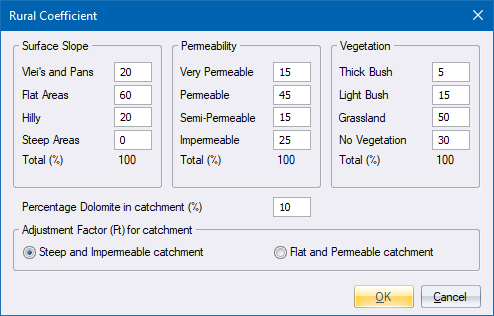
Home > Rural Coefficient Dialog

The runoff coefficient in the Rational Method is an integrated value representing the most significant factors influencing the rainfall-runoff relationship. It represents the part of the storm rainfall contributing to the peak flood runoff at the outlet of the catchment.
There are five main factors which determine the rural runoff - surface slope, permeability of the soil, vegetation, mean annual rainfall and return period. You can specify the percentage makeup of each variable in the editor.
This editor allows you to enter the various values which are used to calculate the rural runoff coefficient.
The program uses these percentage values, plus the following factors, to determine the final rural area factor.
|
Component |
Classification |
Mean |
Average |
Rainfall |
|
< 600 |
600 - 900 |
> 900 |
||
|
Surface Slope |
Vlei's and Pans (< 3%) |
0.01 |
0.03 |
0.05 |
|
|
Flat Areas (3% to 10%) |
0.06 |
0.08 |
0.11 |
|
|
Hilly (10% to 30%) |
0.12 |
0.16 |
0.20 |
|
|
Steep Areas ( > 30%) |
0.22 |
0.26 |
0.30 |
|
Permeability |
Very Permeable |
0.03 |
0.04 |
0.05 |
|
|
Permeable |
0.06 |
0.08 |
0.10 |
|
|
Semi-Permeable |
0.12 |
0.16 |
0.20 |
|
|
Impermeable |
0.21 |
0.26 |
0.30 |
|
Vegetation |
Thick Bush/Plantation |
0.03 |
0.04 |
0.05 |
|
|
Light Bush/Farmland |
0.07 |
0.11 |
0.15 |
|
|
Grassland |
0.17 |
0.21 |
0.25 |
|
|
No Vegetation |
0.26 |
0.28 |
0.30 |
The following classification can be used as a guide to the permeability of the soil.
Very Permeable - Gravel, Coarse Sand.
Permeable - Sandy, Sandy Loam.
Semi-permeable - Silt, Loam, Clayey Sand.
Impermeable - Clay, Peat Rock.
Where dolomite occurs, the following reduction factors will be applied to the rural coefficient for the dolomitic percentage of the catchment.
Vlei's and Pans (< 3%) - 0.10
Flat Areas (3% to 10%) - 0.20
Hilly (10% to 30%) - 0.35
Steep Areas ( > 30%) - 0.50
The return period has an important effect on the run-off percentage. The relationship between rainfall and run-off is not linear, and a catchment is often more saturated at the start of a storm with a long return period than is the case with smaller storms. The rural coefficient will therefore be multiplied by an adjustment factor according to the catchment characteristics. The influence will be smaller for steep and impermeable catchments than for flat and permeable catchments. The Adjustment Factor option allows you to select either steep and impermeable or flat and permeable, and the following factors will be applied during the analysis.
|
Return period (years)
|
2 |
5 |
10 |
20 |
50 |
100 |
|
Factor for steep and impermeable |
0.75 |
0.80 |
0.85 |
0.90 |
0.95 |
1.00 |
|
Factor for flat and permeable |
0.50 |
0.55 |
0.60 |
0.67 |
0.83 |
1.00 |